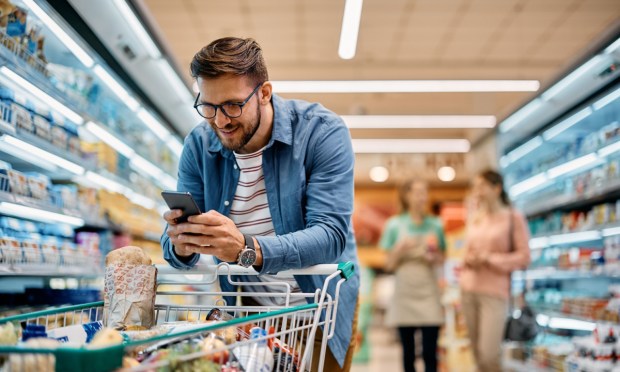Grocery’s Omnichannel Present and Future Highlighted in Latest Big Box Retail Data

Amazon and Walmart — and the pitched battle between the two for all manner of retail spend — gets a fair share of digital ink in these digital pages.
And as the latest stats from our continuing tracker series on the competition between the two show, Walmart holds sway in food and beverage consumer spending, with an almost 19% share, far outpacing Amazon’s roughly 3% share.
How consumers are paying for it all — well, as Karen Webster wrote recently, credit is a key payment method of choice, with buy now, pay later (BNPL) trailing, but still gaining notice.
Dig into the details a bit, as tied to Walmart’s fiscal fourth-quarter results, and the company noted that grocery helped drive same-store comp sales growth of 4% year on year here in the states. The grocery segment was up mid-single-digit percentage points. Walmart has said that the strong comps reflect share gains in dollars and as measured in units, too. Food units grew on the heels of demand for fresh food. The read across here, too, is that there’s a mix of ways that consumers are getting the consumables they need.
On a global basis, eCommerce sales were up 23% in the latest period, accounted for $30 billion and 18% of net sales, and were led by pickup and delivery. If grocery sales are up significantly, pickup is up significantly and delivery has made strides too, it stands to reason that customers are using those channels to go grocery shopping. CFO John David Rainey said on the conference call with analysts that “e-commerce continues to be a key point of differentiation for Sam’s [Club], with delivery and curbside driving e-commerce growth, and in-club scan and go penetration up over 270 basis points.”
And elsewhere on the call, asked about grocery in general, Walmart U.S. President and CEO John Furner said that “as we see more customers using same-day services and express deliveries, and that’s also across a broad range of categories, it would be intuitive to assume it’s food,” though customers are also ordering other items alongside their grocery purchases.
As we detailed in our own coverage of Target’s earnings last week, new offerings are targeting free same-day delivery from the retailer’s on-demand delivery aggregator Shipt. Same-day service, which includes in-store pickup, curbside and Shipt, rose 13.6%, led by strength in curbside. Commentary from the earnings call noted that food and beverage accounts for more than $20 billion in sales, up from $8 billion in sales since 2019.
In further evidence of omnichannel progress, Kroger’s latest earnings results spotlighted that digital sales grew by 10% year on year, and that delivery sales were up 24% year on year. Digitally engaged households were up 18% year on year.
Click and Mortar’s Here to Stay
In the Click and Mortar shopping report just released, we found that that 39% of consumers are now Click-and-Mortar shoppers, engaging across digital and physical channels. And as noted here, a third of grocers are innovating their loyalty programs, while more than a third are broadening and innovating the channels across which they receive payments.
